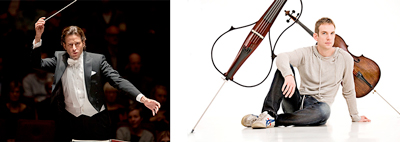by Robert Rollin

The Lalo opens with a cadenza-like solo which Moser played clearly and expressively despite its low register, then exchanged ascending phrases with the principal flute.
The musical conversation continued in the Allegro, as Moser gracefully soared up to the high register of the A string. Powerful orchestral unisons and punctuating chords supported by timpani enlivened the flow.
The Intermezzo began with softly bowed strings and wide expressive leaps in the cello, soft dynamics creating a shimmering effect. Moser graced cadence points with sparkling trills.
After beginning with tasteful solo cello, the rapid Finale added lively syncopations. A luscious oboe solo led to more tutti chords. Gimeno’s brisk conducting created wonderful ensemble throughout.
Two short gems appeared on the program: Maurice Ravel’s Alborada del gracioso (Morning Song of the Buffoon) and Manuel de Falla’s Suite from El amor brujo (Love, the Magician).
The Ravel, based on the fourth movement of the piano piece Miroirs, vacillates between delicacy and intensity in its gorgeous orchestration. Harp and pizzicato strings opened softly and led to a sparkling oboe solo. The strings also used jeté (lightly bouncing) bowing to create a jovial feeling.
Solo statements by muted trumpets, clarinets, bassoons, flutes and harp, supported the feeling of good cheer. Low register bassoon, modernistic brass clusters, powerful tutti’s with piercing flute and piccolo ascending glissandos, xylophone, other high percussion, and a high horn solo, all supported the forceful mood. Gimeno’s brisk conducting made for a memorable performance.
The de Falla also shone through its flamenco-styled, coloristic orchestration. The opening Introduction and Scene offered a kaleidoscope of contrasting soloistic colors including piccolo, clarinet, low contrabasses and muted brass. Atmospheric tremolos by violas, cellos, and basses adorned a penetrating muted trumpet solo.
In the Cave emphasized gentle woodwind sonorities accompanied by soft strings and harp. The contrastingly loud Apparition followed, replete with fortissimo tuttis, full homophonic strings, a delicate saraband-like oboe solo, and a beautiful concertmaster solo. The closing Ritual Fire Dance was stunning.
Gimeno and the Orchestra ended the evening with a magnificent, fast-paced performance of Igor Stravinsky’s Firebird Suite (the 1919 version). The musicians negotiated the Introduction’s intricate solos with sensitivity, and scintillated on the Firebird’s Dance. The Princesses’ Round Dance and the Berceuse were gentle and evocative. King Kaschei’s Infernal Dance and the Finale featured full orchestral pyrotechnics with terrific pacing and ensemble playing. The concert ended early accompanied by thunderous applause.
Published on ClevelandClassical.com August 22, 2017.
Click here for a printable copy of this article



